Palm Tree Seeds: Harvesting & Growing Guide

If you are thinking about buying a palm tree seed and growing your own palm tree from scratch, you need to learn some new tricks. To grow a palm tree seed, you cannot use the similar asexual methods used for propagating other trees.
This is because of the way that a palm tree seed grows. Air layering, cuttings, and division are not as effective as you want them to be when it comes to growing palm tree seeds.
In this article, we are going to talk about these seeds in detail. We are going to discuss what do palm tree seeds look like, how to harvest palm tree seeds, and answer other common questions about them.
Palm Tree Seed Pods
Before getting into what does a palm tree seed look like and how one may harvest them, let’s talk about the pods first.
Palm tree seed pods or fruits are actually the results of the tree’s healthy reproductive cycle. Palm tree flowers are normally very small. And since they are green, you might not be able to distinguish them easily when they blend into the palm tree leaves.
Insects and wind are the agents that transfer pollen from the male flowers to the female flowers, which can also grow on the same palm tree. When the female flowers are pollinated, they grow the fruits at the top of the tree, which will become the palm tree seed pods (coconuts go through the same process as well).
Among different palm trees, date palms produce large clusters of rounds of oval fruits that people around the globe use for snacking or cooking. Each of these sweet fruits contains a stone in the middle, also known as palm tree seed. Let’s see what do palm tree seeds look like.
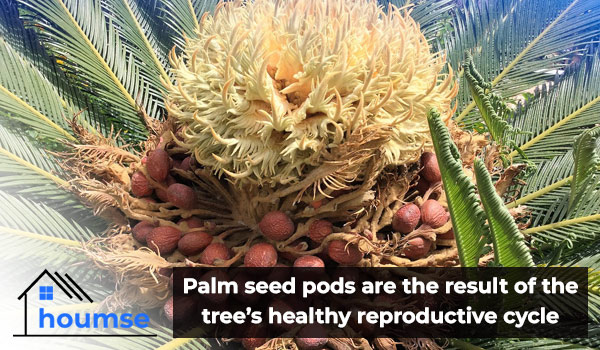
What Do Palm Tree Seeds Look Like
In general, a palm tree (like the pineapple palm) has a tall trunk without branches that supports huge fronds as it grows. Palm tree’s flowers, which turn into fruits containing seeds, bloom on spikes simple or branching. Most of the palm species are tropical, but there are some species that thrive in temperate areas like the Mediterranean as well.
Many palm species produce round seeds that have the size of a walnut. Regardless of their size, every palm seed has an endosperm. The endosperm is like food for the plant embryo. For example, the super hard date palm tree seed is considered the endosperm. The white, oily, and soft coconut flesh is also endosperm.
It is interesting to note that some palm tree seeds are actually called nuts, like the one with the Areca palm. Palm growers often grow new trees from mature palm seeds that they collect when fully ripe. In fact, the edible seeds should not be touched until then.
The fruit, aka the seed pot or seed capsule, has different sizes depending on the species. So, the answer to “what does a palm tree seed look like” changes from one specimen to another. Some are small and red, and some are large and brown like coconuts! Nevertheless, there is a seed nesting in all of them. Here is a quick guide to identifying the seeds of some popular palms:
- Coconut Palms: Their seeds are deep, reddish-purple, with a size and shape similar to a plum.
- Sabal Palms: Their seeds are hard, very small, and somewhat round with black or rusty color.
- Ivory Palms: Their oval seeds have a smooth, tan surface.
- Maripa Palms: Their seeds are about 2 inches long and look like a spindle.
When trying to see what palm tree seeds look like, the texture can be of help too; although it cannot help you identify the species. On the beaches, depending on how long the seed has drifted, the texture may be smooth and polished, or rough.
If you look closely, you may also find specific markings on some of the seeds, and pores at their bottom that the palm will sprout. In the next, we are going to see how to harvest palm tree seeds.
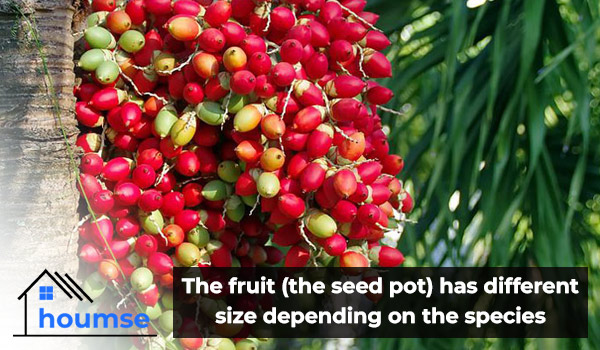
How to Harvest Palm Tree Seeds for Planting
To harvest palm tree seeds from any species (if you already have a palm tree), start with fresh seeds. You should collect the palm tree seed pod as soon as it is ripe. That is when the fruit is showing color or has just fallen from the tree.
It does not matter how many seeds you collect. Freshness is the most important factor when it comes to how to harvest palm tree seeds. A fresh seed tends to sprout more readily and almost guarantees a good result.
To test if you have chosen the right palm tree seed, drop it into a bowl of warm water. If it floats, it is not good. A floating seed in the water lets you know that the palm tree seed does not have the internal organs necessary for reproduction. But if sinks, it will probably work.
This is how to harvest palm tree seeds and you would probably agree that it is fairly easy. However, if you want to buy palm tree seeds, obtain fresh seeds from a reputable dealer. Avoid immature and green seeds. Also, ask the dealer about the age of the seeds. If they are from distant lands, they might not be fresh as you need.
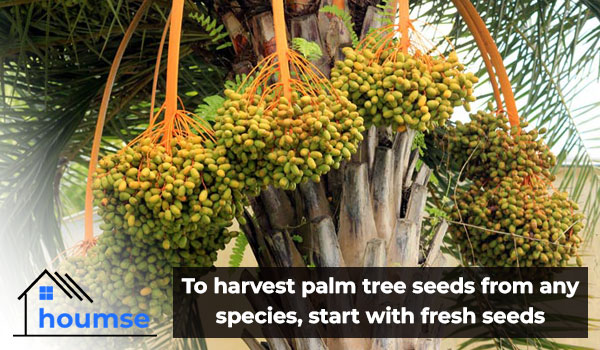
Palm Tree Seed Pod Removal
Now that you know how to harvest palm tree seeds, let’s see what the next steps are to grow them successfully. For growing a healthy tree from a palm tree seed, you need to remove its pod first. Palm seeds have fleshy fruit that you need to remove before planting.
In nature, palm tree seed pod removal is done when birds eat its flesh, or by passing through the gut of an animal. Palm tree seed pod removal increases the possibility of good results by eliminating the chance of fungus growing and therefore contaminating the seed.
In some species, palm tree seed pod removal is as simple as rubbing the flesh under running water away. But in other species, you might need a knife to gently separate the fruit from the seed. If you need to use the knife, be careful not to damage the seed coat that protects the seed interior from entering insects or fungus.
Make sure that you remove the fruit completely and that the seed is not slimy. This is to prevent the seed from rotting later. In addition, you must clean the thin coat off the remaining fruit as well. Pay attention to this step since the wrong palm tree seed pod removal is the most important reason for failure in germinating.
During the palm tree seed pod removal and cleaning, we recommend wearing rubber gloves. As some seeds contain irritants that may irritate the skin; especially the seeds from fishtail palms, royal palms, and Chamaedorea.
During the palm tree seed pod removal, it is good to know that not all fruits are edible. For example, fishtail palms and the ones from the genera Caryotas have inedible flesh. The fruit from these trees even stings if you touch it. Or consider the betel nut palm (Areca catechu). Its fruit is not only mildly toxic but can be addictive as well.
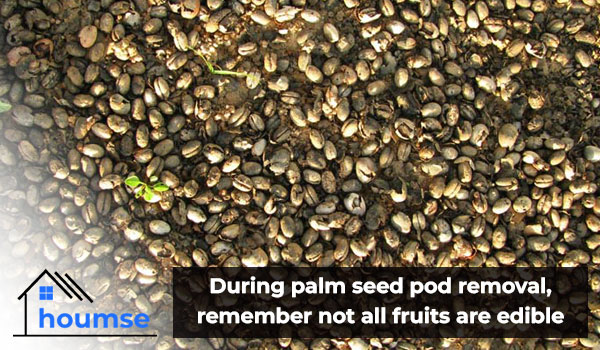
Sprouting Palm Tree Seeds
In nature, palm seeds are dispersed by the wind or animals. Meaning that they are rarely buried before sprouting. Therefore, for sprouting the seed at home, plant it in a small container (not more than 10 inches deep) with a very thin layer of soil. If you bury the seed too deep in the container, it will not readily sprout. For the soil, we recommend mixtures of perlite and peat moss in a 2:1 or 3:1 ratio.
When planting a few seeds and in terms of horizontal spacing them, it is best not to place too many of them into the container. Palm tree seeds that are too close to each other will compete for nutrients, and some might never germinate.
After planting the palm seed, place the container in a very warm and very humid place. A window box in a steamy bathroom is perfect. But if you do not have such a location at your home, wrap the container in a plastic bag and move it to a warm location, like a warm window ledge or on top of the refrigerator.
Light is not an important factor in germinating palm tree seeds. All shady location is good for this process, as long as you maintain the temperature and humidity needs. So, try to fight the temptation of locating your seeds in the sun.
Although this will provide the high temperatures that you need but drying out will be inevitable in that case. You should note that palm tree seeds that fall from the tree in nature usually germinate in a shady location.
Palms are famous for having an erratic behavior in germinating. So, keep in mind that germinating the palm tree seed depends on your palm species. But it will not be very long. Some palm seeds sprout in 70 days, while coconut palms take up to six months to sprout. If the seed starts to look worn out when you are waiting, do not worry. Palm tree seeds can shrivel and otherwise look dead before they sprout.
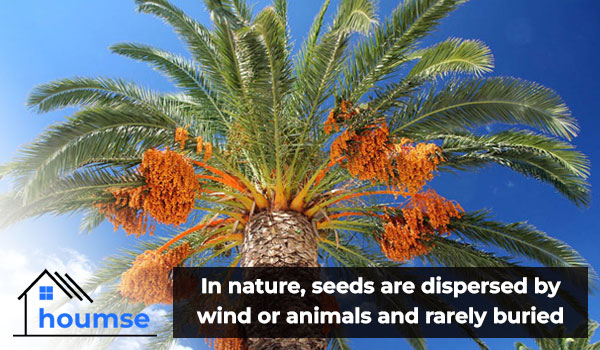
Growing Palm Tree Sprout
As soon as the palm tree seeds have sprouted, place its container in a very warm place (at least 75 F) with relatively high humidity. However, if you are growing palm seeds from arid regions, remember that they require less humidity than seedlings.
Your palm seedlings require abundant light as well (many species thrive in dappled sunlight). If possible, we recommend sprouting palm tree seeds over the winter or in early spring and then moving the young plants outside for their first summer.
Many popular palm species of palm have root shocks after transplanting. So, wait for transplanting young palm trees until they have at least three or four sets of leaves. That is why we mentioned using a container to start palm seedlings which is about 10 inches. Such a container also covers the possibility of aggressive roots. Our article “palm trees roots system” provides more information about palm roots.
The growth rate of palm tree seeds varies depending on the species as well. Some palms including Bismarck grow very slowly. On the other hand, other species such as the Christmas palm grow rapidly after sprouting.
Your palm seedlings do not need fertilizer at first. But once they actively grow, it is good to start applying weak liquid fertilizer. Use a fertilizer that is formulated especially for palm trees. Some say that palm trees do not need fertilizer. But the difference between a good palm tree and a great tree palm is actually fertilizer.
Once your palm seedlings develop several sets of leaves and start to mature, move them into a larger container.
Final Thoughts
Hopefully, now you have the answer to how to harvest palm tree seeds and what do palm tree seeds look like, and you are ready to grow your own tree. Following the steps that we talked about above and having a bit of patience, a majestic palm tree awaits.
If you have any experience regarding harvesting, sprouting, and growing these plants, kindly share them with us and other readers.
- In this post:
- Palm Tree Seed Pods
- What Do Palm Tree Seeds Look Like
- How to Harvest Palm Tree Seeds for Planting
- Palm Tree Seed Pod Removal
- Sprouting Palm Tree Seeds
- Growing Palm Tree Sprout
- Final Thoughts



